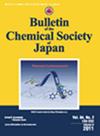Solution-processed ZnO thin film with high-density quantum dots via particle size control strategy
IF 3.3
3区 化学
Q2 CHEMISTRY, MULTIDISCIPLINARY
引用次数: 0
Abstract
Solution-derived ZnO quantum dot is one of the most widely used electron-transport layers in optoelectronic devices. To achieve high-efficiency in optoelectronic devices it is required that a thin film of ZnO quantum dot with low surface roughness and low defect intensity is developed. Herein, alcoholic solvents with different alkyl lengths were utilized to dissolve tetramethylammonium hydroxide to fine-tune the polarity of the solution, to achieve ZnO quantum dots with controllable particle size and monodisperse in alcohol solvents. Two kinds of ZnO quantum dots with particle sizes of 6 and 12 nm detected by dynamic light scattering were successfully prepared by this method. Furthermore, by mixing these two types of quantum dots, ZnO films with a different packing mode were fabricated, which exhibited lower surface defect density and surface roughness. This approach offers a novel pathway to reduce issues such as current leakage associated with ZnO as an electron-transport layer. What's more, the small particle size ZnO quantum dots effectively fill the gaps between the large particle size quantum dots, resulting in a film with a higher density of quantum dots. This increased density contributes to the higher electrical conductivity of the ZnO film.通过粒度控制策略实现具有高密度量子点的溶液加工氧化锌薄膜
溶液衍生氧化锌量子点是光电设备中应用最广泛的电子传输层之一。为了实现光电设备的高效率,需要开发出表面粗糙度低、缺陷强度低的氧化锌量子点薄膜。本文利用不同烷基长度的醇类溶剂溶解四甲基氢氧化铵,对溶液的极性进行微调,以获得在醇类溶剂中粒径可控且单分散的氧化锌量子点。用这种方法成功制备了两种通过动态光散射检测到的粒径分别为 6 纳米和 12 纳米的氧化锌量子点。此外,通过混合这两种量子点,制备出了具有不同堆积模式的氧化锌薄膜,其表面缺陷密度和表面粗糙度均较低。这种方法为减少与作为电子传输层的氧化锌相关的电流泄漏等问题提供了一种新的途径。此外,小粒径氧化锌量子点有效地填充了大粒径量子点之间的空隙,使薄膜具有更高的量子点密度。密度的增加有助于提高氧化锌薄膜的导电性。
本文章由计算机程序翻译,如有差异,请以英文原文为准。
求助全文
约1分钟内获得全文
求助全文
来源期刊
CiteScore
6.40
自引率
5.00%
发文量
194
审稿时长
3-8 weeks
期刊介绍:
The Bulletin of the Chemical Society of Japan (BCSJ) is devoted to the publication of scientific research papers in the fields of Theoretical and Physical Chemistry, Analytical and Inorganic Chemistry, Organic and Biological Chemistry, and Applied and Materials Chemistry. BCSJ appears as a monthly journal online and in advance with three kinds of papers (Accounts, Articles, and Short Articles) describing original research. The purpose of BCSJ is to select and publish the most important papers with the broadest significance to the chemistry community in general. The Chemical Society of Japan hopes all visitors will notice the usefulness of our journal and the abundance of topics, and welcomes more submissions from scientists all over the world.

 求助内容:
求助内容: 应助结果提醒方式:
应助结果提醒方式:


